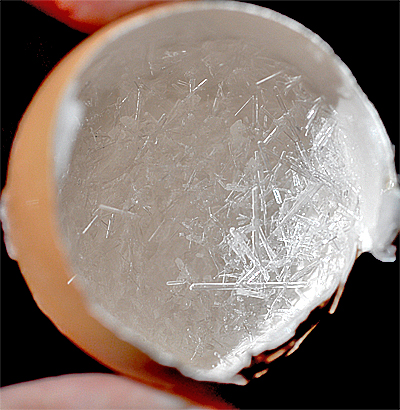
Several people have written me lately, asking how to make simulated geodes in egg shells. Geodes are pockets of crystals that form in sedimentary and igneous rocks. They start as hollow spaces in rock that is porous enough for water to seep through. The water carries dissolved minerals, which are deposited in the open space, forming a lining of crystals. Most geodes contain quartz crystals, but they can also contain calcite, celestite, and other minerals.
Many rock shops and museum gift shops sell geodes that have been cut, and sometimes dyed to make them more colorful. Sometimes you can buy unbroken geodes, which lets you break them open yourself. That is particularly fun, as you never know how it will look until you open it.
If you don't have a place to collect geodes, you can make quick, easy, simulated geodes by using egg shells for the hollow spaces. I have seen several different recipes, many of which take days, but you can make an egg shell geode in a few hours by using epsom salts for the crystals. We will be using basically the same formula that we used for Growing Crystals from Solution, so you will need:
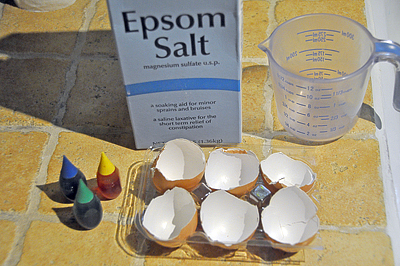
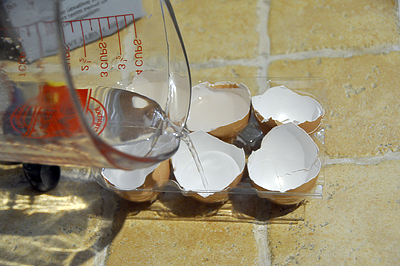
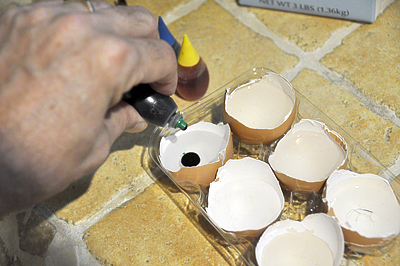
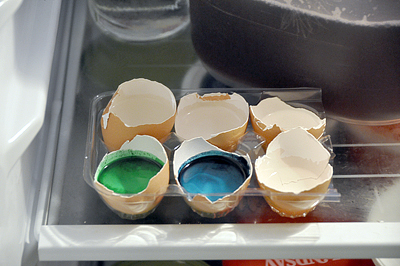
- several egg shells, washed and cleaned
- an egg carton to hold the shells
- epsom salts, available at pharmacies and grocery stores
- HOT water
- a measuring cup
- a refrigerator
- food coloring
Start by making an omelet or something else yummy that requires eggs. For the best results, crack the eggs close to the small end of the egg. This leaves you a fairly large egg shell to use. The larger the egg shell, the more crystals you will have. Wash the shell, and remove the skin-like membrane that lines the shell. For short term projects, you can leave this membrane in place, but you should remove it if you plan to keep your geode for a long time, as the membrane tends to mold after a while.
Depending on how many eggs you are going to use, you may not need as much of the solution as we used before. I tried using 1/4 cup of epson salts and 1/4 cup of hot water, and it worked fairly well for 6 egg shells. You want the water to be hot, but not quite boiling. Stir in the epsom salts. If it all dissolves, add another spoon full. If that all dissolves, add some more. You want to reach the point where there are a few crystals that will not dissolve.
Place the egg shells in the egg carton, so they won't tip over and make a mess. Then pour the epson salt solution into the shells.
If you want brightly colored crystals, add a drop of food coloring. You might even try adding small drops of two or more colors to the same shell. Be sure to leave some of them uncolored, because I think the pure crystals are prettier than the colored ones.
Carefully place the egg carton into the refrigerator. Put it in a place where it will not be bumped or disturbed, and let it sit for at least 3 hours. That will give your crystals plenty of time to form.
Once you have plenty of crystals, remove the egg carton from the refrigerator. There will still be liquid in the shells, which you can carefully pour into the sink. Be careful not to let the crystals fall out of the shell as you drain them. Each shell should have a mass of needle-shaped crystals inside. As they dry, they will become even more bright and shiny.
Troubleshooting:
If you do not get crystals, then either your water was not hot enough, or you did not add enough epsom salts. The water should be very hot, so that it will dissolve a large amount of the epsom salts. Then keep adding the salts until no more will dissolve. The idea is that when the water cools, it will be supersaturated, allowing the crystals to grow quickly.
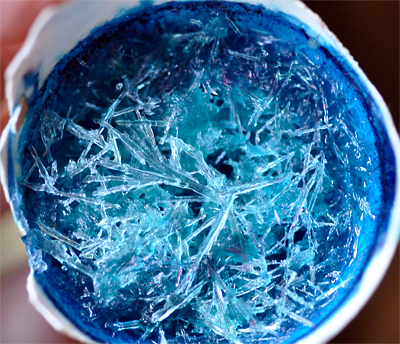
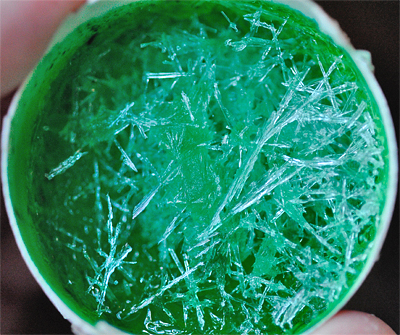

You can play with the concentration of the epson salts. Adding more epson salts to the water will give you a denser cluster of crystals, while adding a bit less will give you a better view of the individual crystals. If you used clean egg shells, your crystals should remain bright and shiny for weeks.
Keep in mind that the crystals are very delicate, and will break easily. They are also water soluble, and may even absorb water from the air in a humid environment, dissolving themselves. If they break or dissolve, don't worry. You can dissolve them in hot water again, and repeat the experiment with the same epsom salts.
